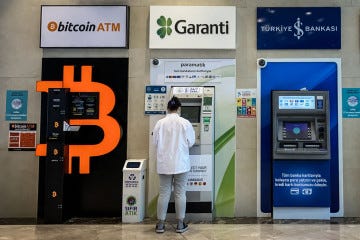Bitcoin Rationalism: A Demand-Driven Approach to Price
With a bull market warming up, how do you separate crypto hype from underlying demand?
Over the past month or so we’ve seen the start of a major rally in Bitcoin, now up 116% on the year. In turn, as it usually does, this has produced even bigger moves in the rest of the crypto market. I’ve seen this pattern at least four times, and (especially given current macro trends around inflation and interest rates) I think we’re poised for a new crypto bull market.
(Full disclosure: I’m talking my book here, and in a much more direct way than people usually mean that. My liquid savings are largely in BTC and ETH, and a continued rally would make my life a loooot easier for the next few months.)
This is going to be totally incomprehensible, and even infuriating, for a certain class of crypto commentator – the “nocoiners,” or holders of what I would call the “Full Ponzi” position. These are people who believe that cryptocurrency is a scam from top to bottom, that the market for Bitcoin is secretly controlled by Tether, and related ideas.

A handful of these nocoiners are loudly ignorant embarrassments. A scant few, like Bruce Schneier, have cogent and technically-informed criticisms.
But most nocoiners, such as the “shrill” Ben McKenzie, are simply swimming in the comfortable water of crypto-skepticism – without, ironically, engaging in a lot of critical thinking about that water. Really, the nocoiner attitude (it’s not really what I’d call an “argument”) has more to do with skepticism of tech investing, venture capital, and capital structures than with cryptocurrency per se.
Those lower-information skeptics face a real problem, though – people actually use Bitcoin, and Ethereum (and even friggin’ Tron, for that matter). And we’re on the verge of an era when that use is far more directly connected to market price, and less buffeted by waves of hype and rhetorical hopium.
At the same time, the past few years have seen a catastrophic degeneration in the level of discourse on the pro-Bitcoin side specifically. “Bitcoin Maximalism” is the idea that Bitcoin will become something close to a global currency, and it was always a red herring, a Pied Piper simplification resting on an emotional appeal. This has become much more obvious as entities like Bitcoin Magazine pivot to cater to a frothing political base rather than people actually interested in financial systems.
That simplification has its uses, but it also has major risks, because it is fundamentally a matter of tribal faith rather than reasoned analysis. In one of the clearer examples, Michael Saylor, a huge Bitcoin evangelist in recent years, has an incomplete and sometimes mistaken understanding of how Bitcoin actually works on a technical level.
Between those two poles – nocoining and Maximalism – there is a fact-based and causal way to understand why Bitcoin, and perhaps other cryptos, will have an enduring place in global financial infrastructure. We’re getting closer to a sensible market where the Bitcoin price is actually driven by underlying demand for uncensorable, global blockspace, from the specific, constrained group of users who need the features the system offers.
I’ve been thinking about this for a while, and the approach has proven out. Way back in early 2014, I spoke to Stanford’s Susan Athey, who used a demand-based model to predict that Bitcoin would eventually reach a price of $50,000 per token. On the day of publication, the BTC price was $621.
So yeah, I’d say It’s Time to Get Rational.
Don’t forget - a much deeper dive into the fundamental, long-term transformative potential of crypto can be found in my book, Bitcoin is Magic: Internet Money, Memetic Warfare, and the End of Mere Reality.
Measuring Bitcoin
Now, let’s clarify that a “rational” analysis of Bitcoin demand/price is not the same as a mathematical model of Bitcoin price. If anything, they’re in opposition: as I’ll be continuing to argue, practices like technical analysis may (big emphasis on may) have short-term predictive power. But they offer absolutely no insight into the specific ways that a novel technology will fit into the functioning of global society, and therefore no insight into the medium- and long-term price of any crypto.
This is why “quants” like Sam Bankman-Fried and Su Zhu so deeply misunderstood the nature of crypto markets, and wound up so permanently, life-fuckingly rekt. Don’t be like Sam and Su!
The fact that I was able to see a $50,000 Bitcoin prediction as credible in 2014, by contrast, had relatively little to do with math or projections. It was rooted in thinking through actual demand and applications. Use cases for Bitcoin are very specific and limited, and include:
Small to medium sized international businesses that don’t operate at enough scale to make correspondent banking worthwhile, but who also want to reduce per-transaction fees.
Individuals without access to reasonably stable fiat currency. This includes nations from Argentina to Turkey to Nigeria.
Both of these are very, very real sources of demand for BTC blockspace. The nocoiners have don’t have a particularly good rebuttal to the fact that, however imperfect they may be, these systems are actually used by real people in their day to day lives.
Gambling and Blockspace
Trading, aka “price gambling,” is also a very popular current use case for practically all blockchains, from Bitcoin on down. But this gambling, and the volatility it both exploits and perpetuates, are the market’s attempts to see into the future of daily, on the ground use. As usage grows relative to speculation, volatility declines, in turn discouraging gamblers further.
Obviously BTC and other legit cryptos will always have a place for market-makers, but that role will be commoditized over time and both windfall profits and sudden catastrophic losses will decline. This is what I often refer to metaphorically as the collapsing wave function of finance. In quantum mechanics, a collapsing wave function is the convergence of two superpositioned states into one “reality.” In finance, the collapse takes place between price – the speculative state – and real-world demand.
(This is the essence of finance as a form of time travel. For more on this concept, see my series Venture Capital on Arrakis.)
Moving on:
The endurance of Bitcoin over the course of 2023 is broadly incompatible with the nocoiner viewpoint (less compatible than the current rally, in fact, for reasons I’ll get into). That’s because the Full Ponzi case would argue that entities like Three Arrows Capital, Celsius, and FTX deceptively inflated crypto prices through a mix of leverage (buying Bitcoin with borrowed cash) and hype (Su Zhu’s utterly brain-damaged “supercycle” thesis).
(There is a counterargument that the same actors, including FTX, may have undercut the BTC price because they were effectively trading in “paper” Bitcoin without actually holding the underlying asset. As a rough heuristic, I’d say the inflating forces, particularly hype, seem stronger than this deflating force.)
But in reality, actual usage of the Bitcoin network to move value was, while not precisely “stable,” definitely durable even during the absolute depths of the “bear market” last year.
Check out this Blockchain.com chart of on-chain Bitcoin transaction volumes in USD (Blue line) against Bitcoin price (Black line). You have to squint to filter out the spikiness of the volume line (I’m genuinely unsure what those microcycles are, they’re too long for day/night), but the overall takeaway is pretty clear.
This chart tracks hype and speculation. It shows the beginning of a new speculative cycle. But just as important, by letting us see hype, it also lets us see what is not hype.
That’s because on-chain BTC volume is reasonably likely to reflect day-to-day end-user activity. Speculative activity, especially in BTC specifically, is substantially confined to exchanges, who usually use omnibus wallets of pooled assets to minimize on-chain activities and save money on fees. (This isn’t quite as dramatic in ETH, where speculative trading activity takes place on-chain at scale.)
Notice that, on a relative basis, price outruns baseline demand during the bubble/bull market from 2020-2022. That’s true even though the bull market itself adds some level of on-chain activity. By contrast, during the doldrums of 2022, price is much lower relative to on-chain transaction volumes. Eventually, in a commoditized marketplace, the entire chart would have the same steady character – price tied to network volume, which in different words could be called “demand for blockspace.”
Then, in early 2023, we see price move further away from transaction volume in relative terms. This is the beginning of another hype cycle. It has been largely fueled by a fundamentally speculative catalyst – the increasing likelihood of a Bitcoin ETF approval in the United States.
A Bitcoin ETF would lead to a huge increase in the delta between Bitcoin price and on-chain activity levels – likely even more than exchanges, ETFs will not be doing a lot of transacting on-chain.
There may be something I’m missing, but I think it’s possible the ETF approval is one of the last big catalysts of a sudden inflow of new capital to BTC. That is, it’s one of the final legal, structural barriers to people betting on their belief in Bitcoin’s future.
Depending on how you think about markets, that might mean the approval gets us closer to the ‘correct’ price of Bitcoin. Or it might mean there’s another huge runup that will inevitably collapse once real demand for blockspace doesn’t grow at the same pace. I tend to believe the latter, which is why the ETF launch may be a “sell the news” moment – a big pop followed by underwhelming medium-term performance.
We Need More Facts, Not More Theory
Finally, a digression on data: It is shockingly (some would say embarrassingly) difficult to find actual throughput data about the Bitcoin network. It’s not that the information itself is obscure – like most other metrics about crypto, the data is public and theoretically easy to pull. But it seems very few crypto data firms go to the effort of packaging it into usable charts available to the public, suggesting there isn’t a huge amount of demand for data about the actual underlying (ahem) demand for Bitcoin blockspace. Blockchain.com’s was the best I found, and its actual tools aren’t that great.
By the same token, there’s still relatively little journalistic reporting on how real people are using Bitcoin in the real world. There has been almost no coverage in the West, for instance, on the existence of major Bitcoin street markets in countries like Turkey, where it is becoming integrated into the traditional hawala system. (We saw just how disastrous this lack of granularity can be with the wave of near-baseless and weaponized speculation about Hamas’ crypto activities.)
That is, there’s oddly little public interest in the actual drivers of Bitcoin price. This should be no surprise to the properly cynical – if there’s one thing that ten years as a finance reporter has driven home, it’s how bafflingly irrational market actors are, particularly in crypto, where individual retail traders have more influence.
That may also be more true with regard to BTC because a huge number of people who watch Bitcoin full-time are committed to some form of Bitcoin Maximalism – an ideological goal rather than an analytical framework. That’s fair enough for true believers. But Maximalism is a faith, not a reasonable or useful way to think about Bitcoin’s market value if you’re interested in trading or investing in it. Nocoining is, if anything, less rational still.
Somewhere in the middle of those two ideologies is reality.








